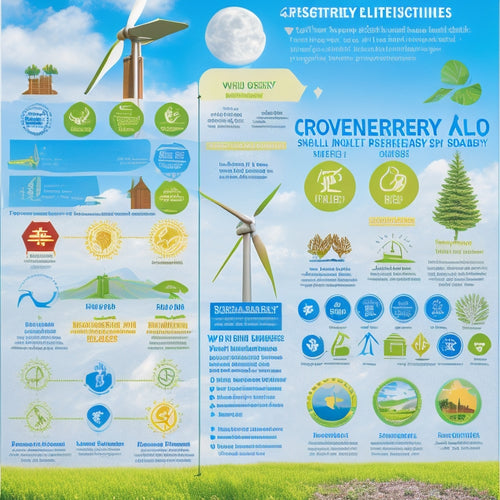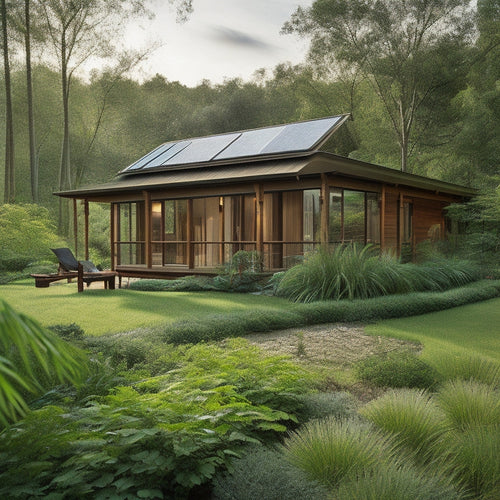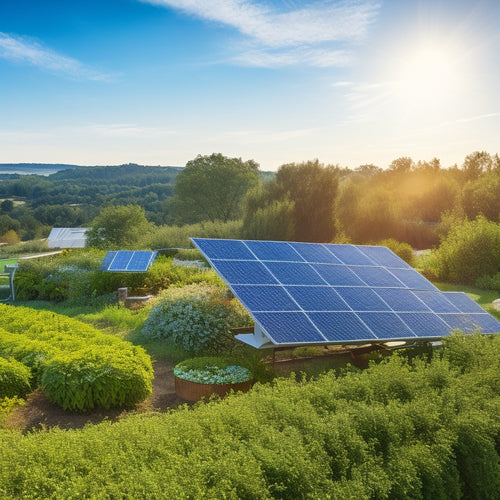
A 7-Step Guide to Solar Panel Setup for Your House
Share
You're about to begin a quest to transform your home's energy environment by utilizing the power of solar energy, and with the right guidance, you can navigate the installation process with confidence. First, assess your energy needs by analyzing your current usage patterns and accounting for future changes. Next, choose the right solar panels based on efficiency, durability, and cost. Then, select a reputable installer, plan your solar panel layout, and prepare your roof and site. After that, install the solar panel system, connect it to the grid safely, and monitor its performance. Now that you've started, you'll want to investigate each step in more detail to guarantee a seamless shift to solar power.
Key Takeaways
- Assess your energy needs by analyzing past electricity bills and accounting for household occupants, appliances, and lighting requirements.
- Choose the right solar panels by considering panel efficiency ratings, types of solar cells, wattage, and voltage needs for your household.
- Select a reputable installer who meets industry standards, has adequate insurance coverage, and provides proof of certifications and licenses.
- Plan your solar panel layout by determining optimal solar orientation, conducting shading analysis, and choosing a panel configuration that fits your roof size and shape.
- Ensure a safe and efficient installation by verifying grid voltage and frequency, installing ground fault protection devices, and scheduling routine maintenance checks.
Assessing Your Energy Needs
To determine the size of your solar panel system, you need to evaluate your energy needs. This involves conducting an energy consumption analysis to understand your current energy usage patterns.
Review your past electricity bills to identify your average daily energy consumption in kilowatt-hours (kWh). Consider the number of occupants in your household, the type and number of appliances, and the lighting requirements to get an accurate representation of your energy needs.
Next, make future energy projections based on your lifestyle changes, such as adding new appliances or expanding your living space. This will help you determine the required capacity of your solar panel system.
You can use online tools or consult with a solar panel professional to estimate your energy needs. Be sure to account for seasonal variations in energy consumption, as this will impact the system's performance.
Choosing the Right Solar Panels
You'll need to evaluate several key factors when selecting the right solar panels for your setup.
First, you'll want to assess panel efficiency ratings, which measure how well a panel converts sunlight into electricity.
You'll also need to choose between different types of solar cells, such as monocrystalline or polycrystalline, and determine the required wattage and voltage to meet your energy needs.
Panel Efficiency Ratings
Most solar panels on the market today boast efficiency ratings between 15% and 22%.
But what does this mean for you? Fundamentally, it's a measure of how well a panel converts sunlight into usable electricity. A higher efficiency rating means more power per hour of sunlight. When choosing a panel, you'll want to evaluate the efficiency rating in conjunction with the panel's size and your available roof space.
You'll also want to assess the efficiency comparison between different panels. A 1% increase in efficiency mightn't seem like much, but it can add up over the panel's lifespan.
For example, if you're deciding between a 17% efficient panel and a 19% efficient panel, the latter could generate an additional 200-250 kWh per year, depending on your location and sunlight exposure.
When making your decision, be sure to weigh the increased upfront cost of a more efficient panel against the potential long-term energy savings.
Types of Solar Cells
When evaluating solar panels, efficiency ratings are just one aspect to bear in mind. You also need to assess the type of solar cells used in the panels, as they impact performance, durability, and cost.
There are three main types of solar cells to choose from:
-
Monocrystalline solar cells: These cells are made from a single crystal of silicon, offering higher efficiency rates (15-20%) and better low-light performance. Monocrystalline advantages include higher power output per hour of sunlight and a longer lifespan.
-
Polycrystalline solar cells: These cells are made from multiple silicon crystals, making them less expensive to produce. Polycrystalline differences include lower efficiency rates (12-15%) and slightly lower durability.
-
Thin-film solar cells: These cells use a thin layer of photovoltaic material, making them flexible and lightweight. Thin film innovations include lower production costs and flexibility in design.
- Hybrid solar cells: These cells combine different materials to achieve higher efficiency rates and improved durability.
Solar cell durability is critical, as it directly impacts the lifespan of your solar panel system.
Wattage and Voltage Needs
The size of your solar panel system depends on your energy requirements, which are measured in watts. To determine your wattage needs, you'll need to calculate your total daily energy usage. This can be done by adding up the wattage of all your appliances and devices, multiplied by the number of hours you use them per day.
| Appliance | Wattage |
|---|---|
| Refrigerator | 150-200 W |
| Air Conditioner | 500-1000 W |
| Lights | 20-50 W |
| TV | 50-100 W |
| Computer | 60-100 W |
When choosing the right solar panels, you'll also need to take into account the voltage of your system. Most residential solar panels operate at 12 or 24 volts, while grid-tied systems typically require 240 or 480 volts. Confirm your solar panels are compatible with your grid connection and battery storage system, if applicable. Keep in mind that higher voltage systems are more efficient, but may require specialized equipment.
Selecting a Reputable Installer
You'll want to guarantee your installer has the necessary proficiency, so check for industry certifications like NABCEP (North American Board of Certified Energy Practitioners) or UL (Underwriters Laboratories) certification.
Additionally, verify that the installer has adequate insurance coverage, including workers' compensation and liability insurance, to protect yourself and their employees in case of accidents.
Check Industry Certifications
Frequently, homeowners overlook an essential step in the solar panel installation process: verifying industry certifications. You must confirm that your chosen installer meets the required industry standards to guarantee a safe and efficient installation.
Certification bodies like the North American Board of Certified Energy Practitioners (NABCEP) and the International Association of Electrical Inspectors (IAEI) set the benchmarks for solar panel installers. These organizations certify installers who've demonstrated proficiency in designing and installing solar panel systems.
- Look for certifications like NABCEP's Certified Solar PV Installer or IAEI's Certified Solar PV System Inspector
- Check if the installer is a member of industry associations like the Solar Energy Industries Association (SEIA) or the National Electrical Contractors Association (NECA)
- Verify if the installer has received training from manufacturers like SunPower or Tesla
- Confirm the installer has a valid license to operate in your state
Verify Insurance Coverage
Selecting a reputable installer means guaranteeing they've got you covered in case something goes wrong. You want to verify their insurance coverage to protect yourself from potential risks and financial losses.
Ask your installer about their insurance policies, including workers' compensation and liability insurance. These policies should provide sufficient coverage limits to cover damages or injuries during the installation process.
Don't be afraid to request proof of insurance, such as certificates of insurance or policy documents. This will give you peace of mind and guarantee you're not held liable in case of an accident.
Verify the coverage limits and policy duration to confirm they align with your project's timeline and scope. A reputable installer should have adequate insurance coverage to mitigate risks and provide financial protection.
Planning Your Solar Panel Layout
Planning the layout of your solar panel array is an essential step in maximizing energy production and ensuring a safe, efficient installation.
You'll need to take into account several factors to optimize your system's performance.
To get started, you'll want to:
- Determine the best solar orientation for your panels, considering the direction your roof faces and any obstructions that might affect energy output.
- Conduct a shading analysis to identify areas of your roof that receive full sun, partial shade, or full shade, and adjust your layout accordingly.
- Choose the right panel configuration to accommodate your roof's size, shape, and structure.
- Consider the electrical connections and wiring required to integrate your solar panel system with your home's electrical grid.
Preparing Your Roof and Site
Before installing your solar panel array, you'll need to prepare your roof and site to guarantee a safe and efficient installation. Assess your roof's condition to confirm it can support the weight of the solar panels. Check for damaged, missing, or loose tiles, and repair or replace them as needed.
Conduct a shading analysis to identify any obstacles that might cast shadows on your solar panels, such as trees or nearby buildings. Verify your roof's structural integrity by checking its age, material, and load-bearing capacity.
Research local regulations regarding solar panel installations, including permits, zoning laws, and building codes. Consider your roof's orientation and the ideal installation angle for maximum energy harvesting.
Take into account weather considerations, such as high winds, heavy snowfall, or extreme temperatures, to confirm your solar panels can withstand them. Finally, plan for accessibility, including safe access to your roof and sufficient space for maintenance and repairs.
Installing the Solar Panel System
With your roof and site prepared, you're now ready to install the solar panel system. This involves mounting the solar panels on your roof, connecting them to an inverter, and installing a monitoring system to track performance.
-
Mounting solar panels on your roof, guaranteeing a secure and watertight seal
-
Connecting the panels to an inverter, which converts DC power to AC power for your home
-
Installing a monitoring system to track the performance of your solar panel system
- Obtaining installation permits and scheduling inspections with local authorities
You'll need to choose the right solar panel types for your installation, considering factors like efficiency, durability, and cost.
Be certain to select panels that meet local building codes and regulations. Additionally, obtain the necessary installation permits and schedule inspections with local authorities to guarantee a smooth and compliant installation process.
Connecting to the Grid Safely
Your solar panel system is now installed, and it's time to connect it to the grid. This is a critical step that requires attention to grid safety measures to guarantee a smooth and secure grid connection process. The grid connection process involves synchronizing your solar panel system with the grid's electrical frequency and voltage.
To guarantee a safe and successful connection, you'll need to:
| Grid Safety Measure | Description |
|---|---|
| Lockout/Tagout | Ensure the main electrical panel is locked out and tagged to prevent accidental startup during connection |
| Voltage and Frequency Check | Verify the grid's voltage and frequency match your solar panel system's specifications |
| Ground Fault Protection | Install ground fault protection devices to prevent electrical shocks |
| Overcurrent Protection | Install overcurrent protection devices to prevent electrical overloads |
Monitoring and Maintaining Performance
Now that your solar panel system is up and running, it's vital to keep a close eye on its performance to guarantee you're maximizing your energy output and identifying any potential issues early on.
Performance monitoring is essential to confirm your system operates at peak levels. You'll want to track your energy consumption and production in real-time, using software tools that provide detailed performance metrics.
Some key aspects to focus on include:
-
Routine maintenance: Schedule regular checks to verify all components are functioning correctly, and perform inverter checks to prevent overheating or other issues.
-
Efficiency tracking: Monitor your system's efficiency to identify areas for improvement and enhance energy output.
-
System diagnostics: Use built-in diagnostic tools to troubleshoot issues quickly and minimize downtime.
- Weather considerations: Take into account weather patterns and seasonal changes that may impact your system's performance.
Incentives and Ongoing Support
Several incentives can greatly offset the initial investment of your solar panel system, and it's essential to examine these benefits to maximize your returns.
You're eligible for federal tax credits, which can cover up to 26% of your system's cost. Additionally, local rebates and financing options may be available to further reduce your upfront expenses.
You can also benefit from renewable energy certificates (RECs), which represent the environmental attributes of one megawatt-hour of renewable energy. Installation grants and energy efficiency programs can provide additional financial support.
Community solar initiatives allow you to participate in a shared solar panel system, reducing your energy costs and environmental impact.
Lastly, utility incentives, such as net metering, enable you to generate your own electricity and export any excess to the grid. These incentives can notably reduce your energy bills and payback period.
Be sure to research and investigate these opportunities to optimize your solar panel system's financial benefits. By taking advantage of these incentives, you can enjoy a faster return on investment and maximize your energy savings.
Frequently Asked Questions
Can I Install Solar Panels on a Metal or Clay Tile Roof?
You can install solar panels on a metal or clay tile roof, but you'll need to take into account roof compatibility and unique installation considerations, such as specialized mounting systems and potential weight constraints, to guarantee a secure and efficient setup.
Do Solar Panels Work During a Power Outage?
Ha! You think solar panels are like superheroes that'll save you from a power outage? Sorry, not quite. During an outage, your solar panel functionality shuts down for safety reasons, but with the right power outage solutions, like battery backup, you can stay powered up!
Can I Sell Excess Energy Back to the Grid?
You can sell excess energy back to the grid through net metering benefits, which allow you to offset your energy consumption and even earn credits; many utilities also offer energy buyback programs, further monetizing your renewable energy investment.
How Often Should I Clean My Solar Panels?
As you bask in the radiant glow of your solar panels, remember that dusty surfaces can dim their sparkle. You should clean them every 6-12 months as part of regular solar panel maintenance to guarantee peak energy harvesting and maximize your power output.
Are Solar Panels Covered Under My Homeowner's Insurance?
You'll likely find that your homeowner's insurance policy covers solar panels, but review your policy to confirm; also, check your solar panel warranties, as they may provide additional insurance coverage or overlap with your existing policy.
Conclusion
You've made it! You've successfully maneuvered the 7-step path to utilizing the power of the sun for your home. Now, you're ready to reap the benefits of clean energy and watch your electricity bills plummet like a rock. With your solar panel system up and running, you'll be producing enough energy to power a small town (okay, maybe not that much, but you get the idea!). Seriously, though, you've taken a significant step towards reducing your carbon footprint and securing a more sustainable future.
Related Posts
-

Renewable Energy Certifications for Businesses
Renewable energy certifications are essential for your business, showcasing your commitment to sustainability and enh...
-

Affordable Sustainable Building Materials for Homes
You can build an eco-friendly home on a budget by choosing affordable sustainable materials. Consider using reclaimed...
-

Green Energy Alternatives for Independent Living
To enhance your independent living, consider green energy alternatives like solar panels and wind turbines. These opt...


